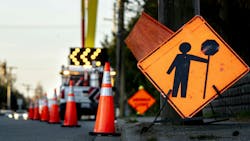FHWA Report Makes Recommendations to Contractors on Safety in Work Zones
Since 2016, heavy trucks and buses have been involved in almost a third of fatal crashes in work zones, according to the National Highway Traffic Safety Administration (NHTSA). In 2016, 196 crashes (29%) in a work zone involved these vehicles, classified as commercial motor vehicles by NHTSA. In 2020, the last year in which data is available, 774 fatal crashes occurred in work zones. CMVs were involved in 208 of these crashes (27%). A recent report from the Federal Highway Administration (FHWA) in collaboration with the NHTSA outlines why and provides a coordinated strategy for contractors and other stakeholders to reduce the risk of CMV crashes.
Even though there was a slight decrease in CMV-involved work zone fatal crashes in work zones in 2020, CMVs are consistently overrepresented in fatal work zone crashes compared to fatal non-work zone crashes, according to the report.
Read more: Safe paving practices at Ajax Paving
Most CMV-involved fatal work zone crashes also occurred on interstates (52%). These crashes were evenly divided between rural and urban areas, and the most common type of crash involving a CMV was a rear-end collision (46%).
There are several reasons this overrepresentation of CMVs might exist according to the report, including physical constraints of roadways under construction. Lane closures, restricted lane widths and lateral clearances, and shortened merge and diverge areas make it difficult for CMVs to navigate work zones.
How contractors can make work zones safer
While existing CMV and work zone initiatives provide resources about a broad range of strategies that can be used to improve the safety of work zones for all users, the report outlines direct voluntary actions contractors can take to address CMV safety specifically in work zones.
According to the report, engineering plays a critical role in the design of work zones as it pertains to analyzing crash data, identifying, designing, and implementing safety improvements, and designing and conducting training of staff.
One suggestion for engineers is the design of access/egress points and acceleration/deceleration on active roadways to ensure the safe exiting and return of vehicles to the work zone.
Driver education includes the development and delivery of public service announcements, behavioral safety campaigns, and training targeted at CMV and non-CMV drivers when driving through work zones.
The report makes the following action item recommendations for contractors:
Engineering
- FHWA suggests contractors train personnel on best practices for work zone access point design principles and use the information to help design and locate access points when they are not specified in contract plans.
Driver Education
- FHWA recommends including construction truck drivers in safety training requirements for employees. This could entail developing and implementing in-house training about best practices for entering and exiting the workspace at access/egress points and acceleration/deceleration on an active roadway. Contractors could consider requiring construction subcontractors to provide proof of such training.
- FHWA recommends, on a project-by-project basis, that project supervisors consider discussing access/egress points and acceleration/deceleration on an active roadway with construction delivery truck drivers and subcontractors to ensure they are entering and exiting the work zone appropriately.
About the Author
Harlee Hewitt
Harlee is a former associate editor for Construction Equipment.
